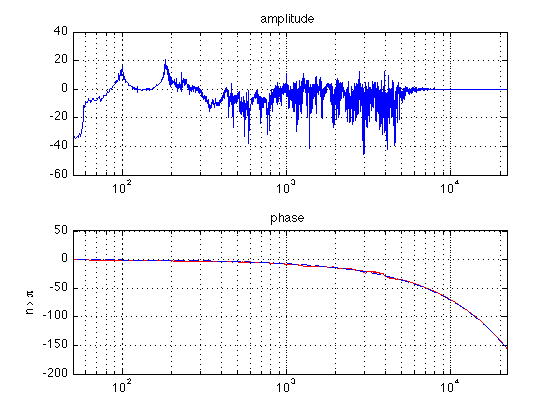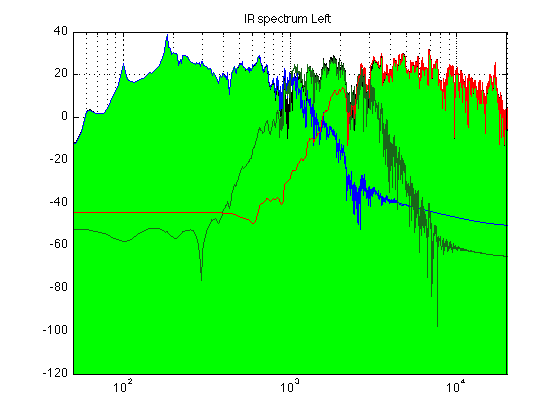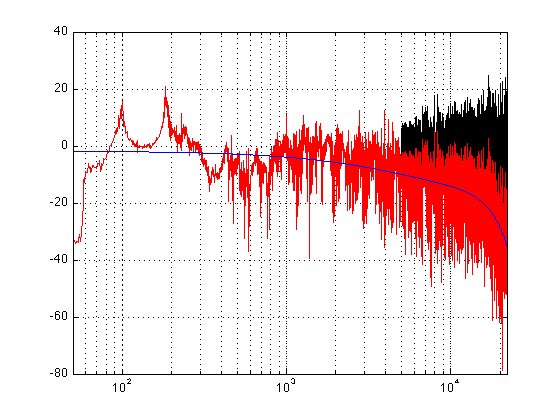
 |
|
#46
|
|||
|
|||
|
Hi everyone,
here are some new IRs. Now I have an IR sounds that does not need blending the dry signal like the Fishman Aura to sound good. Finally, I kept the restoring process, the cleaning of the metallic soundings was too much work, even for an automated program... And I also abandonned the Newton way (ToneDexter). Well I did a lot of trial and error... The main new thing is that I correct the phase from the high end part that I have artificially set flat (see picture). The phase can indeed be modeled easily. The red curve on the bottom is the phase. On the left it's real IR build from the recordings and from 5Khz to 20kHz it's the model. Basically it follows the delay that sound waves experience when propagating in air (speed of sound=340m/s)... I could measure this way the distance between the external microphones and the pickup... funny.  Well including that, I got rid of a kind of water sounding that we could have in the restoring process. I also discovered that my process is somehow nonlinear, so I have a new parameter here. Here is the sound of the Amulet: Here are the external microphones Here are the IR 100% no blending, with nonlinear parameter to 10. The crossover frequency is set to 5kHz. Here are the IR 100% no blending, with nonlinear parameter to 15:, my personal favourite: Here are the IR 100% no blending, with nonlinear parameter to 30 That's a darker one. I think I have something good now.
__________________
Martin 00-18V Goldplus + internal mic (2003) Martin OM-28V + HFN + internal mic (1999) Eastman E6OM (2019) Trance Audio Amulet Yamaha FGX-412 (1998) Gibson Les Paul Standard 1958 Reissue (2013) Fender Stratocaster American Vintage 1954 (2014) http://acousticir.free.fr/ Last edited by Cuki79; 11-08-2016 at 05:46 PM. |
|
#47
|
|||
|
|||
|
OK
I have figured it out. The amount of high end I put back (the flat part of the spectrum is the same) whatever the initial IR. So when the initial IR has stronger volume then Bass are favoured against the high end. 10 corresponding to the last picture. 20 corresponding to 6dB boost of the left part of the IR (non flat part) 30 corresponding to 9.5dB boost of the left part of the IR (non flat part) and thus a darker tone.
__________________
Martin 00-18V Goldplus + internal mic (2003) Martin OM-28V + HFN + internal mic (1999) Eastman E6OM (2019) Trance Audio Amulet Yamaha FGX-412 (1998) Gibson Les Paul Standard 1958 Reissue (2013) Fender Stratocaster American Vintage 1954 (2014) http://acousticir.free.fr/ |
|
#48
|
|||
|
|||
|
Nice, that Amulet and IR 15 sound sample sounds great.
Really loving this thread, although I'm going to need to read it through again to understand it fully. Any plans to apply some of these IR findings with in guitar mics, like the Lyric? |
|
#49
|
|||
|
|||
|
Hi Neon Soul,
This thread follows an old one that was dedicated to the Lyric http://www.acousticguitarforum.com/f...d.php?t=447334 However I did not try yet the new process on the Lyric. I don't have microphones, preamp and audio interface good enough. The help of people like Doug Young expended the experiment to piezo pickup, soundboard transducer and dual source pickup
__________________
Martin 00-18V Goldplus + internal mic (2003) Martin OM-28V + HFN + internal mic (1999) Eastman E6OM (2019) Trance Audio Amulet Yamaha FGX-412 (1998) Gibson Les Paul Standard 1958 Reissue (2013) Fender Stratocaster American Vintage 1954 (2014) http://acousticir.free.fr/ Last edited by Cuki79; 11-09-2016 at 01:06 PM. |
|
#50
|
|||
|
|||
|
Lost between rectification and restoration.
Doug's Stereo Rig: External Microphones Homemade IR: Restoration process, no blending, no phase compensation, alpha=20. Nice, lack or air Homemade IR: Rectification process, no blending, no phase compensation, alpha=20. A bit more air/room than Restoration 20, but too much The restoration process sounds good but lacks of metal/air resonance/room reverb that you get too much in the rectification process... I oscillate between both. It also depends on volume. If you listen to the microphones take at low volume on headphones: It matches with the Restoration process at high volume. But if you listen to the microphones take at high volume on headphones: It matches with the Rectification process at medium volume. Do you people also hear that? Maybe it's a Fletcher and Munson thing. I'll work on that tomorrow... Cuki
__________________
Martin 00-18V Goldplus + internal mic (2003) Martin OM-28V + HFN + internal mic (1999) Eastman E6OM (2019) Trance Audio Amulet Yamaha FGX-412 (1998) Gibson Les Paul Standard 1958 Reissue (2013) Fender Stratocaster American Vintage 1954 (2014) http://acousticir.free.fr/ Last edited by Cuki79; 11-09-2016 at 04:33 PM. |
|
#51
|
|||
|
|||
|
Cuki, let's say Doug has his live-performance rig setup to perform with an IR file that finally sounds just way he wants to sound with his excellent fingerstyle playing. Then, a few songs into his set, if he decides to play a flatpicking tune, would he have to have a flatpicking-based IR loaded in his rig and switch to it to have the guitar sound good or could the fingerstyle-based IR work well? Thanks.
__________________
Martin HD-28 Sunburst/Trance M-VT Phantom Martin D-18/UltraTonic Adamas I 2087GT-8 Ovation Custom Legend LX Guild F-212XL STD Huss & Dalton TD-R Taylor 717e Taylor 618e Taylor 614ce Larrivee D-50M/HiFi Larrivee D-40R Blue Grass Special/HiFi Larrivee D-40R Sunburst Larrivee C-03R TE/Trance M-VT Phantom RainSong BI-DR1000N2 Emerald X20 Yamaha FGX5 Republic Duolian/Schatten NR-2 |
|
#52
|
|||
|
|||
|
Hi Sprucetop,
I would say at the level I am fine tuning this I think you can get a good sound for both . Let me explain why: Here I am fine tuning to improve a sound that Doug took years to find and that suits his playing. Of course this is a very subtle and defined sound. So making it closer to microphones is a real challenge. (Lyric and DPA was easy compared to that) But If I can get to this sound, then I can get to any sound. Because it is a very complex and subtle one. So if you need a generic sound, what you have to do is place your microphones so you get a nice stereo image that suits both fingerstyle AND flatpicking (which is the average wellknow position XY, MS...). That's Fishman approach, they did not propose different playing style: They proposed different microphones. There is always one that suits every situation. However, as you mentioned, you may need two sounds live. For example, you need a mid-boost to cut through, or let's be crazy: a chorus....Then you can still buy a Torpedo and have midi implementation to switch IRs. If you are playing mono, you can also take an A/B pedal and wire the two channels of the EPSI to the A/B pedal to get two sound with a footswitch (no switching delay then  . .If you need more, then you have to manualy turn the wheel on the pedal and push one button (limited to 999 IRs per SD card). If you really need a footswitch, I am sure that with an arduino and some soldering skills you can mod your EPSI pedal. (It's just a rotary encoder and a footswitch, nothing impossible). ...I think most of the time, the P.A you get, does not allow to make any difference between subtle sounds.
__________________
Martin 00-18V Goldplus + internal mic (2003) Martin OM-28V + HFN + internal mic (1999) Eastman E6OM (2019) Trance Audio Amulet Yamaha FGX-412 (1998) Gibson Les Paul Standard 1958 Reissue (2013) Fender Stratocaster American Vintage 1954 (2014) http://acousticir.free.fr/ |
|
#53
|
|||
|
|||
|
Here is an updated version of the rectifying process using sum instead of mutiplication. WIth the new process I don't amplify much the metallic sounding resonances on the high end... You can still hear them some times because of some zing. But most of the time it's OK.
The zing occurs round 6kHz and 12kHz. To get rid of that easily, I need new recordings with a bigger part of playing in the highest positions of the guitar... or ven better some string tapping or slap  Slapping like a bass player to et more of that metallic sound... Slapping like a bass player to et more of that metallic sound..... or it can be corrected by hand, frequency by frequency. (It's not so difficult but it takes some time...). Maybe I could just shorten the ringing and it would be OK. Pickup: Mic: IR normalized, cut by hand (turn up the volume to match the dynamic): IR not normalized (turn up the volume to match the dynamic) IR 1KHz rectification for less zing There is still a small lack of low mid range... But it can be EQued. I think I am OK Please tell if you think It's right. I think I can't do much better and I start to run out of idea (and motivation). So I'll wait for some new external inputs. Bye, Cuki
__________________
Martin 00-18V Goldplus + internal mic (2003) Martin OM-28V + HFN + internal mic (1999) Eastman E6OM (2019) Trance Audio Amulet Yamaha FGX-412 (1998) Gibson Les Paul Standard 1958 Reissue (2013) Fender Stratocaster American Vintage 1954 (2014) http://acousticir.free.fr/ Last edited by Cuki79; 11-11-2016 at 12:34 AM. |
|
#54
|
|||
|
|||
|
Hi everyone,
Here is the new rectification process applied to the Amulet alone. Doug Young's playing Amulet: Mics: IR (5KHz a=20 omega=100): IR slightly sweeter attack parameters (1KHz a=20 omega=75) Increase volume to enjoy.
__________________
Martin 00-18V Goldplus + internal mic (2003) Martin OM-28V + HFN + internal mic (1999) Eastman E6OM (2019) Trance Audio Amulet Yamaha FGX-412 (1998) Gibson Les Paul Standard 1958 Reissue (2013) Fender Stratocaster American Vintage 1954 (2014) http://acousticir.free.fr/ Last edited by Cuki79; 11-12-2016 at 04:01 AM. |
|
#55
|
||||
|
||||
|
Cuki and I have been going back and forth offline, and today I tried his latest IRs in the Logidy EPSI pedal for the first time. So these are "live" samples. I played thru my pedal board with the pedal bypassed, then played the same riff again with it on. Directly recorded out of my pedal board into my recording interface. No EQ changes, etc, just the IR off, then on. I did slightly adjust the levels afterwards, the IR process currently seems to make the sound a bit quieter, which can apparently be compensated for eventually. The file names are related to some sort of naming convention Cuki has been using to keep track of the different processing he's done.
__________________
Music: Spotify, Bandcamp Videos: You Tube Channel Books: Hymns for Fingerstyle Guitar (std tuning), Christmas Carols for Fingerstyle Guitar (std tuning), A DADGAD Christmas, Alternate Tunings book Online Course: Alternate Tunings for Fingerstyle Guitar Last edited by Doug Young; 11-13-2016 at 01:20 AM. |
|
#56
|
|||
|
|||
|
Those sound really good Doug. Subtle, but really help smoothing out the pickup sound.
I think the cut in the transducers mid frequency, on the IR file, is also contributing to a perceived cut in volume. Is there no way to boost volume using the pedal? I thought the effects level was a +/- dB control? |
|
#57
|
||||
|
||||
|
Quote:
__________________
Music: Spotify, Bandcamp Videos: You Tube Channel Books: Hymns for Fingerstyle Guitar (std tuning), Christmas Carols for Fingerstyle Guitar (std tuning), A DADGAD Christmas, Alternate Tunings book Online Course: Alternate Tunings for Fingerstyle Guitar |
|
#58
|
|||
|
|||
|
Hi everyone,
I think I can solve that. I tried a small program that measures the loudness based on Fletecher Munson curves. It does predict a 2dB differences between the two last files as we have corrected. Now I have to adjust the IRs. In the worst case scenario, the AMT pangea has presets that include volume. So if you want to switch you can use this one (becareful no footswitch)... I am not sure it's stereo (it has stereo output option but the files seems to be mono: Sorry my Russian is really old now...) On the AMT website: формат ("i.e. format "):48kS/sec 24bit Mono. Cuki
__________________
Martin 00-18V Goldplus + internal mic (2003) Martin OM-28V + HFN + internal mic (1999) Eastman E6OM (2019) Trance Audio Amulet Yamaha FGX-412 (1998) Gibson Les Paul Standard 1958 Reissue (2013) Fender Stratocaster American Vintage 1954 (2014) http://acousticir.free.fr/ |
|
#59
|
|||
|
|||
|
The new Pangea CP-100FX includes stereo and volume, 5 band fully parametric EQs, FXs, DI out, MIDI...
http://amtelectronics.com/new/amt-pangaea-cp-100fx/ But it's 495$... about twice the price of the standard Pangea or logidy EPSI. It's funny because the DSP sharc cost itself 25$ and an evaluation kit the same price... What would be nice is to model the nonlinearity of the acoustic guitar... If I had the time... But it's safer to be patient. There are already companies doing nonlinear convolution with Voltera series so when the DSP are fast enough we will get that. https://www.acustica-audio.com/index...180&Itemid=306 My point of view is that IRs are an "always on" things: like the Fisman Aura. There is no footswitch to change images... Seems that nobody complained. I mean there is two ways of using it: 1) You can use it to have a "more" natural sound. Then you only need a single IR because there is no "more natural" than "more natural" (lol). 2) You can use it to have a larger than life sound. Then I think you don't really need an IR because there are already so many things on the market that does "larger than life sounds".
__________________
Martin 00-18V Goldplus + internal mic (2003) Martin OM-28V + HFN + internal mic (1999) Eastman E6OM (2019) Trance Audio Amulet Yamaha FGX-412 (1998) Gibson Les Paul Standard 1958 Reissue (2013) Fender Stratocaster American Vintage 1954 (2014) http://acousticir.free.fr/ |
|
#60
|
|||
|
|||
|
Hi everyone,
Now the process enables to tune separately 3 bands. On each band you can tune the length of the notes and its amplitude. I don't put anymore the parameters (they are 11) Trance Amulet alone (mono): External microphones (stereo): 3bands IR: The new spectrum IR is like that:  If you remember from previous post with old rectification process it basically looked like that (maybe a bit improved in the last posts)  So the 3 band process enables me to clean the midrange without compromizing the low end. In the last posts, I only cleaned the high end. I've discovered that too much cleaning in the midrange is not good. Here there are still a lot of small "accidents" in the spectrum but keeping these midrange "ringing" gives a bit of metallic reverb that microphone takes usually have... Well I tried to keep that. (But I can make it sound clinical and very straight now if I want). I also gave the midrange a slight boost, because it was lacking. The high end gets an extra cleaning with a very short IR/reverb tail and a firm boost to compensate for. Now the sum of the 3 bands (green) is very smooth compared to the previous IR spectrum. You can't really see it at the intersection of the bands, but it is much smoother. Now improving the sound is mostly about tuning the 11 parameters. (amplitude, start time of decay, decay rate x 3 bands + 2 crossover frequencies) If SpruceTop is still reading the thread I'd be to glad give a try to the Taylor ES2. I have a ES1.3 on my Taylor and if it sounds good I may pay the 300 bucks for upgrading to ES2 (It can't work on magnetic systems). You only have to send me 4 wav files. Cuki
__________________
Martin 00-18V Goldplus + internal mic (2003) Martin OM-28V + HFN + internal mic (1999) Eastman E6OM (2019) Trance Audio Amulet Yamaha FGX-412 (1998) Gibson Les Paul Standard 1958 Reissue (2013) Fender Stratocaster American Vintage 1954 (2014) http://acousticir.free.fr/ |